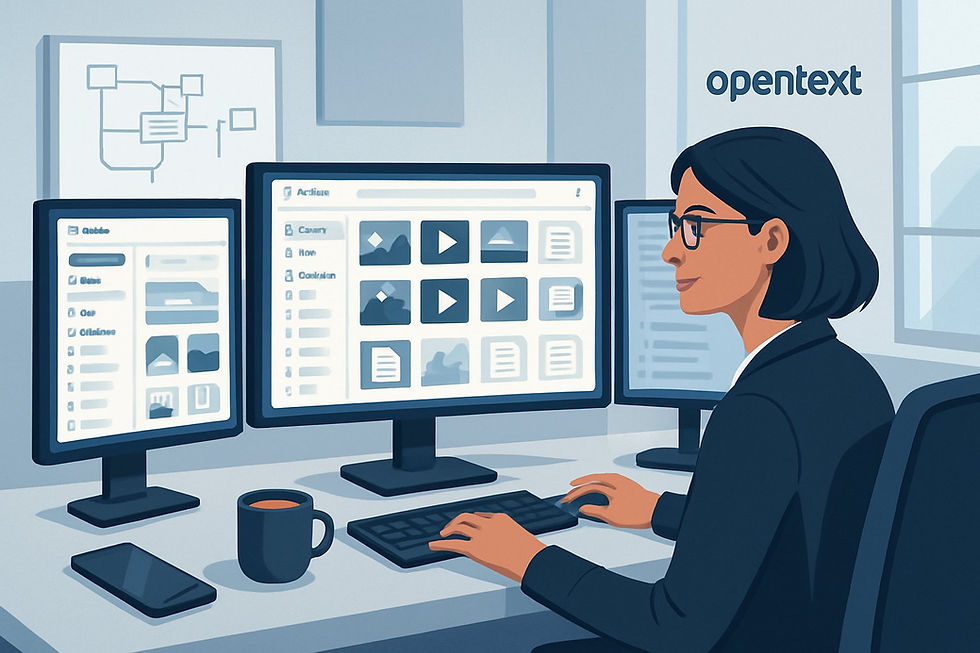Digital Asset Management Jobs: 7 High-Paying Career Opportunities in 2025
- The Master Sensei

- Sep 13
- 7 min read
Digital asset management (DAM) is now essential for organizations juggling tons of digital content—think images, videos, documents, and brand assets. As companies lean more on digital media for marketing, communications, and daily operations, they need people who can wrangle, optimize, and distribute these assets. The demand for skilled DAM professionals has really taken off.

This field covers a lot of ground—from technical pros who run DAM systems to creative folks who manage content workflows. You’ll find these jobs everywhere: media companies, tech giants, marketing agencies, and big enterprises. Whether you want a steady full-time gig, prefer freelancing, or you’re after a specialized technical role, digital asset management opens doors if you’ve got the right mix of tech know-how and organizational chops.
1) OpenText Media Management Specialist
OpenText Media Management (OTMM) specialists dive into digital asset management systems, helping companies keep digital files—images, videos, docs—in check.
You’ll need at least five years of hands-on experience with OTMM software. Knowing how digital assets move through different systems is a must. You’ll end up handling asset uploads, connecting systems, and smoothing out kinks when things break.
Most OTMM specialists work with version 10.5 and spend their days solving technical snags, whether on servers or user interfaces.
The job leans heavily on admin skills for OTMM and related tools. You’ll help users access and manage digital files and keep the system humming along.
Lots of these jobs are remote. Companies like Kaiser Permanente bring in OTMM specialists to wrangle marketing content, test new features, and manage updates.
Specialists also onboard new users, set up accounts, and train people on OTMM basics. You’ll work closely with IT and marketing teams.
If you’re into tech and like helping people, this role could be a sweet spot—it’s a blend of technical troubleshooting and user support.
2) Digital Asset Manager at Media Companies
Media companies need digital asset managers to keep their video files, photos, and audio content organized. You’ll find these roles at TV stations, movie studios, newsrooms, and streaming services.
Every day, a digital asset manager at a media company sorts through thousands of files. They tag videos with keywords so editors and reporters can find what they need in a flash. They back up important footage to avoid disaster if something goes wrong.
Digital asset managers team up with creative folks like editors and designers. They make sure everyone has the right files at the right time, and they keep tabs on which content gets used in different projects.
Live broadcasts and breaking news? Media companies count on these managers to dig up old footage or photos for stories and prep content packages for shows.
You’ll need to know your way around media file formats and storage systems. Most media companies use specialized software for digital libraries, so getting comfy with those tools is key.
Experience with video editing software is a big plus. Media companies love candidates who get how journalists and producers work with digital content.
3) Creative Director with DAM Expertise
Creative directors who know digital asset management lead creative teams and keep digital content workflows on track. They mix artistic vision with a solid grasp of DAM systems.
These directors oversee projects from kickoff to delivery. They make sure every digital asset follows brand guidelines and stays organized in the DAM platform.
They rely on tools like Adobe Experience Manager and Brandfolder, integrating DAM systems into creative workflows to boost efficiency.
Day-to-day, they review creative work, manage asset libraries, and train team members on DAM best practices and approval steps.
Companies really value creative directors who get both design and tech. They’re the bridge between creative teams and IT.
Usually, you’ll need 8–10 years of creative experience plus DAM know-how. Leadership skills matter since you’ll manage several people.
Creative directors with DAM chops work in agencies, media companies, and big brands. They help keep visual identity consistent across all digital channels.
This role blends creative decision-making with system management—making these directors indispensable for companies churning out loads of digital content.
4) DAM Systems Administrator
DAM Systems Administrators run the technical side of digital asset management platforms. They keep systems running and jump in fast when things go sideways.
They handle setup and daily maintenance. Making sure DAM software plays nice with other company systems is part of the job.
DAM admins create user accounts and set permissions, deciding who can access what in the system.
They train new users on uploading, organizing, and finding digital files.
Admins keep an eye on system performance and storage space. They upgrade software and roll out new features when it’s time.
Working with IT to keep things secure is a big deal—setting up backups and protecting files from loss or theft.
Most jobs want database management experience, plus a knack for metadata and file organization.
You’ll need to solve technical problems quickly and communicate well, especially when training users or collaborating with other teams.
5) Content Manager with DAM Skills
Content managers who know DAM juggle traditional content strategy and digital asset organization. They create content plans and manage the files that make those plans happen.
They organize images, videos, and docs in DAM systems, write content calendars, and manage publishing schedules. This combo keeps content and assets working together.
Content managers with DAM skills tend to earn more. They know file naming, metadata tagging, and version control—making them extra valuable to marketing teams.
Companies want content managers who can use DAM software like Adobe Experience Manager and Brandfolder. Learning these tools opens up more roles.
The job takes both creative and technical thinking. Content managers plan what and when to publish, and make sure the right files are easy to find and use.
If you like mixing strategy with organization, this could be your thing. Content managers with DAM skills often move up to director roles or specialize further down the line.
6) Freelance Digital Asset Manager
Freelance digital asset managers work independently, taking on projects for different clients. They help companies get their digital files in order, often remotely.
Freelancers pick their projects and set their schedules. They help with system implementation and create workflows so teams can find and use assets faster.
Most freelance gigs start as short-term contracts—maybe three months, sometimes longer if things go well.
Companies bring in freelancers when they need DAM expertise for a specific project, like a system launch or big reorganization.
Freelance DAM managers need strong organization skills and a good grasp of different DAM platforms and best practices.
They work with creative teams and other departments, so communication is key—especially since they’re always teaming up with new people.
There are tons of freelance DAM jobs out there. You get flexible hours and can work from anywhere.
Rates depend on your experience and the project’s complexity. Many freelancers end up with long-term clients who need ongoing DAM help.

7) DAM Integration and Workflow Analyst
DAM Integration and Workflow Analysts connect digital asset management systems with other business tools. They make sure all the software plays well together.
They study how teams handle digital files now, spot workflow problems, and design better processes to save time and cut down on mistakes.
Integration specialists link DAM systems to social media, design software, and content management systems. They set up automatic file transfers between programs.
Workflow analysts map out how content moves from creation to final use. They design step-by-step processes for teams, including approval chains and review stages.
They work with IT to troubleshoot and test new connections, making sure files transfer correctly. Training staff on new workflows is part of the job, too.
Companies call in these analysts when they’ve got a bunch of tools that need to work together. You’ll need to understand both tech and business needs.
Most jobs want experience with a variety of software platforms, and knowing APIs and system integration helps you stand out.
Essential Skills for Digital Asset Management Jobs
DAM professionals need solid technical skills to work with specialized software. They also have to communicate well to collaborate with teams and manage workflows.
Technical Proficiency Requirements
You’ll want to get comfortable with several key software platforms. Adobe Creative Suite is the go-to for content creation and editing—think Photoshop, Illustrator, InDesign.
DAM platform expertise is a must. Popular systems include Adobe Experience Manager, Bynder, and Widen. Each one has its quirks for organizing and distributing files.
Metadata standards knowledge matters for tagging and categorizing assets. That means understanding Dublin Core, IPTC, and custom taxonomy systems. Good metadata makes files searchable and useful for everyone.
File format knowledge keeps everything compatible across systems. DAM pros should know when to use JPEG, PNG, TIFF, MP4, and others, depending on the job.
Soft Skills and Communication
Project management helps you juggle requests and deadlines. You’ll track asset status, manage approvals, and make sure stakeholders get what they need on time.
Clear written communication is crucial for asset descriptions and user guides. DAM pros write metadata, instructions, and training docs that others depend on.
Team collaboration lets you work well with creative teams, marketing, and outside vendors. DAM pros connect groups with all kinds of technical backgrounds.
Attention to detail keeps mistakes from slipping through. Even small errors in tagging or file names can make important content impossible to find later.
Problem-solving skills come in handy when tech issues pop up or when teams need a creative fix for asset management headaches.
Career Growth in Digital Asset Management
DAM professionals can move up from entry-level coordinator roles to senior management. Industry organizations and networking groups offer resources for skill-building and career moves.
Professional Development Opportunities
Several organizations help you grow in DAM. The Digital Asset Management Professionals (DAMPros) group connects peers and shares best practices. The Association for Information and Image Management (AIIM) has resources and training, too.
These groups offer access to the latest trends and job leads. Members can go to conferences, webinars, and workshops to level up their skills.
Key development areas include:
Metadata management and taxonomy creation
Digital rights management
Content workflow optimization
Technology platform expertise
Project management skills
Many DAM pros go after certifications in project management or information systems. Companies often chip in for training or conference costs.
Typical Career Pathways
Entry-level roles usually center on organizing and tagging digital assets. Most people kick off their careers as digital asset coordinators or assistants, handling basic file management and entering metadata. It’s not glamorous, but hey, everyone starts somewhere.
After a few years—let’s say three to five—you might move up to a mid-level spot like digital asset manager. At this stage, you’re running asset libraries, managing workflows, setting user permissions, and handling system integrations. It’s a lot more responsibility, and you’ll probably find yourself juggling tasks you never expected.
Common career progression:
Digital Asset Coordinator
Digital Asset Specialist
Digital Asset Manager
Senior Digital Asset Manager
Director of Digital Asset Management
Senior roles get more strategic. Directors lead teams, coordinate across departments, and often have a real say in tech choices and budget decisions. It’s a different game at that level—lots more big-picture thinking and, honestly, more meetings than you’d probably like.
Some folks eventually branch out into areas like content marketing, creative operations, or even information architecture. It’s not a one-way street; there’s room to explore.
















































Comments